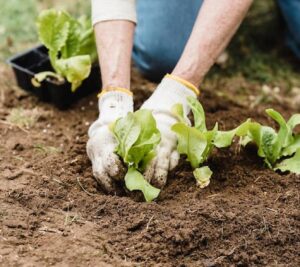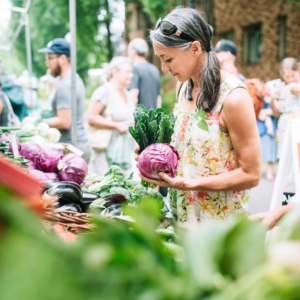
Farmer’s markets bring fresh, locally grown food to urban and rural communities. They build relationships between members of the community and farmers, providing farmers with a source of income and community members with confidence in the food they buy for their families. Farmer’s markets can play a key role in combating food deserts. (The term food deserts describes neighborhoods and communities that have limited access to affordable and nutritious foods.) Farmer’s markets help people access high-quality produce, which helps improve diet, reduce food insecurity and promote general community health.
People shopped at markets for produce 8,000 years ago in ancient Egypt. At first it was a barter system. If an Egyptian wantedfresh vegetables from one of those markets, then they had to trade something for it or offer a service. About 3,000 years later a “cash economy” started in Egypt and people could purchase produce with money. The idea for the “farmer’s market” as we know it today probably started in Lancaster, Pennsylvania in 1730. When city planners designed the city, they determined that a 120-square-foot lot in the town’s center should serve as a public marketplace. They called it the Lancaster Central Market. In 1889, the original Market was replaced by a 20,540-square-foot brick market. Today it remains an important community hub. “Meet me at the Market!” is a phrase commonly heard by Lancaster citizens to this day.
 Farmer’s markets continued to be popular in the United States through the 18th and 19th centuries. They were important for urban communities’ economic success as they increased social interaction and served as primary means for customers to obtain meats, dairy and fresh produce. They remained popular until about the end of World War II, when grocery stores and supermarkets became prevalent. The increase in income that came with the postwar economic boom combined with the convenience these stores delivered led consumers away from farmer’s markets. For a time.
Farmer’s markets continued to be popular in the United States through the 18th and 19th centuries. They were important for urban communities’ economic success as they increased social interaction and served as primary means for customers to obtain meats, dairy and fresh produce. They remained popular until about the end of World War II, when grocery stores and supermarkets became prevalent. The increase in income that came with the postwar economic boom combined with the convenience these stores delivered led consumers away from farmer’s markets. For a time.
Eventually people missed the freshness, quality, and taste of locally grown produce. They also missed the opportunity to support local farmers. The upsurge in consumer interest in eating fresh, locally grown food started in the 1970s and picked up in the early 1990s. Consumers again wanted a connection to local farmers, and community leaders sought to have farmer’s markets in their communities to answer demand. They also wanted them for maintaining a local agricultural base, spurring economic activity and remedying the problem of food deserts.

Farmers’ markets in the US have reportedly grown from 1,755 in 1994 to more than 8,200 in 2014. There were 107 farmer’s markets in New York City alone in 2012, and 88 in Los Angeles. In 2021, 5,345 farmer’s markets (and direct marketing farmers) were authorized to accept SNAP-EBT nationwide, according to the USDA.
The O League plans for a farmer’s market at the Villages Community Marketplace on Federal St. in Burlington, N.J., to open in August. Our farmer’s market will provide local residents with access to fresh, locally produced fruit, vegetables, meats, baked goods and more. The Opportunity League is excited to partner with Rancocas Creek Farm (RCF), a project launched by the Pinelands Preservation Alliance (PPA) in 2020.
The Rancocas Creek Farm is a 72-acre property that adjoins PPA headquarters in Southampton. Farm-fresh, chemical-free food that is high quality, diverse in nature, seasonal and fresh for the consumer is grown on site. The RCF’s crop list features hundreds of varieties; for instance, they grow typical red beets but also beets that are golden, striped red and white, and cylindrical in form. The O League shares RCF’s “love for the magic and fulfillment of fresh food grown with care,” and we are looking to share RCF’s produce with the Burlington-area community.
We anticipate the Villages Community Marketplace will be a place where people can access fresh produce at our farmer’s market and meet their neighbors. Our outdoor stage for events and space for exhibits aims to get people together to learn, grow, enjoy live music and visual arts, in addition to enjoying delicious, fresh food. Our farmer’s market is poised to help resolve the food desert problem in our area, while the larger Villages Community Marketplace will serve as a regional cultural hub.
We hope you will join us.
References:
Burlington County Farmers Market
Farmer’s Market Coalition
Farmers Markets as Community Centerpieces
https://www.usda.gov/about-usda/news/blog/farmers-markets-community-centerpieces
“Meet Me at the Market” – The Evolution of a Farmers Market
https://www.usda.gov/about-usda/news/blog/meet-me-market-evolution-farmers-market
Rancocas Creek Farm
The Public Health Effects of Food Deserts: Workshop Summary
https://www.ncbi.nlm.nih.gov/books/NBK208016/
Which farmers market is the best? Vote now!
https://10best.usatoday.com/awards/best-farmers-market/
[/fusion_text][/fusion_builder_column][/fusion_builder_row][/fusion_builder_container]


